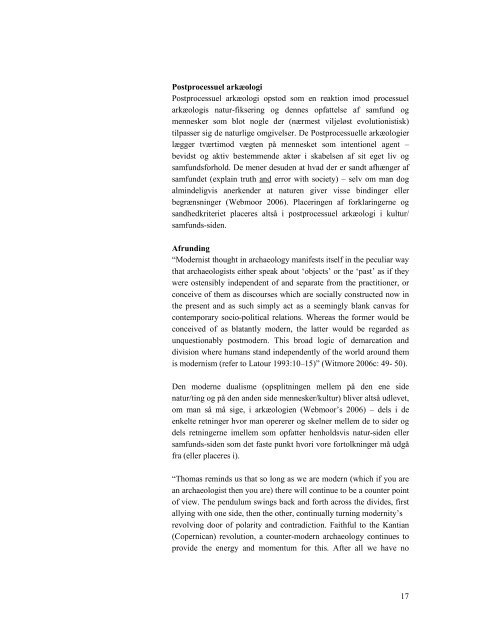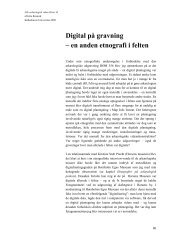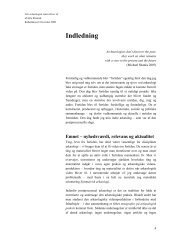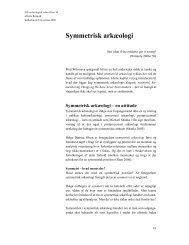Arkæologi og Modernitet - Jette Rostock
Arkæologi og Modernitet - Jette Rostock
Arkæologi og Modernitet - Jette Rostock
Create successful ePaper yourself
Turn your PDF publications into a flip-book with our unique Google optimized e-Paper software.
Postprocessuel arkæol<strong>og</strong>i<br />
Postprocessuel arkæol<strong>og</strong>i opstod som en reaktion imod processuel<br />
arkæol<strong>og</strong>is natur-fiksering <strong>og</strong> dennes opfattelse af samfund <strong>og</strong><br />
mennesker som blot n<strong>og</strong>le der (nærmest viljeløst evolutionistisk)<br />
tilpasser sig de naturlige omgivelser. De Postprocessuelle arkæol<strong>og</strong>ier<br />
lægger tværtimod vægten på mennesket som intentionel agent –<br />
bevidst <strong>og</strong> aktiv bestemmende aktør i skabelsen af sit eget liv <strong>og</strong><br />
samfundsforhold. De mener desuden at hvad der er sandt afhænger af<br />
samfundet (explain truth and error with society) – selv om man d<strong>og</strong><br />
almindeligvis anerkender at naturen giver visse bindinger eller<br />
begrænsninger (Webmoor 2006). Placeringen af forklaringerne <strong>og</strong><br />
sandhedkriteriet placeres altså i postprocessuel arkæol<strong>og</strong>i i kultur/<br />
samfunds-siden.<br />
Afrunding<br />
“Modernist thought in archaeol<strong>og</strong>y manifests itself in the peculiar way<br />
that archaeol<strong>og</strong>ists either speak about ‘objects’ or the ‘past’ as if they<br />
were ostensibly independent of and separate from the practitioner, or<br />
conceive of them as discourses which are socially constructed now in<br />
the present and as such simply act as a seemingly blank canvas for<br />
contemporary socio-political relations. Whereas the former would be<br />
conceived of as blatantly modern, the latter would be regarded as<br />
unquestionably postmodern. This broad l<strong>og</strong>ic of demarcation and<br />
division where humans stand independently of the world around them<br />
is modernism (refer to Latour 1993:10–15)” (Witmore 2006c: 49- 50).<br />
Den moderne dualisme (opsplitningen mellem på den ene side<br />
natur/ting <strong>og</strong> på den anden side mennesker/kultur) bliver altså udlevet,<br />
om man så må sige, i arkæol<strong>og</strong>ien (Webmoor’s 2006) – dels i de<br />
enkelte retninger hvor man opererer <strong>og</strong> skelner mellem de to sider <strong>og</strong><br />
dels retningerne imellem som opfatter henholdsvis natur-siden eller<br />
samfunds-siden som det faste punkt hvori vore fortolkninger må udgå<br />
fra (eller placeres i).<br />
“Thomas reminds us that so long as we are modern (which if you are<br />
an archaeol<strong>og</strong>ist then you are) there will continue to be a counter point<br />
of view. The pendulum swings back and forth across the divides, first<br />
allying with one side, then the other, continually turning modernity’s<br />
revolving door of polarity and contradiction. Faithful to the Kantian<br />
(Copernican) revolution, a counter-modern archaeol<strong>og</strong>y continues to<br />
provide the energy and momentum for this. After all we have no<br />
17





